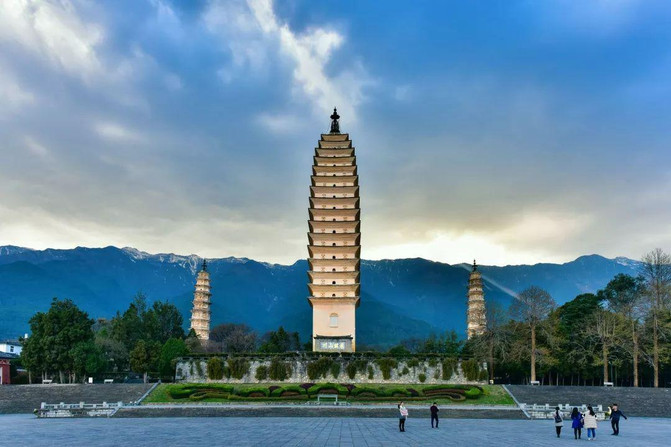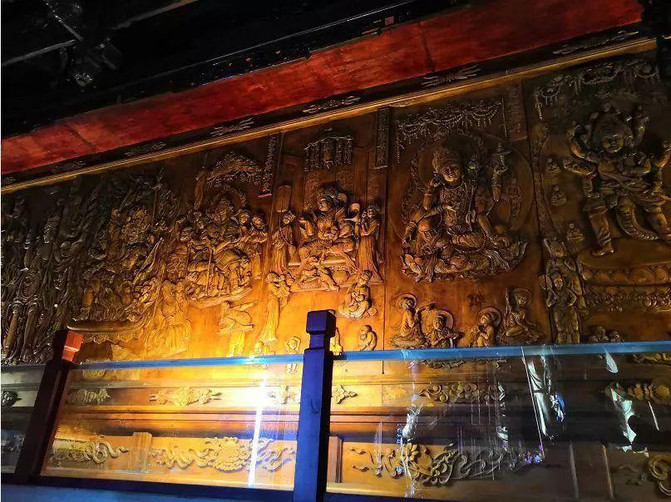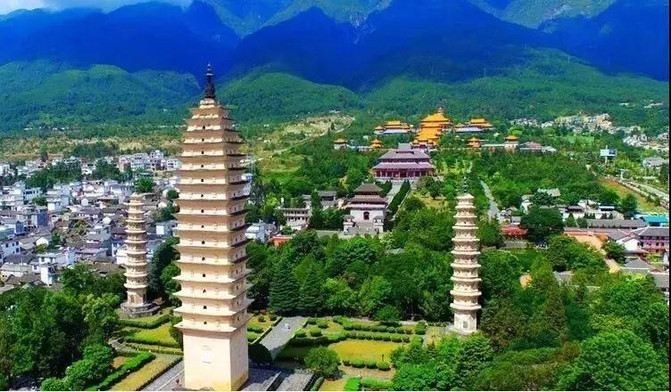Why is the status of the three towers of Chongsheng Temple in Dali so lofty? Go back to the source and listen to the story behind it
What does Dali look like in your eyes?
In the eyes of many people, Dali is the towering Cangshan Mountain, the clear and clear Erhai Lake, the dazzling culture of Nanzhao, and the simple and sweet smile of a Bai girl.

Even the place in "Princess Huanzhu" where crape myrtle said that "every household has flowers and every household has water"... It is the poem and distance that many people yearn for.

But the Dali in my eyes is the three pagodas of Chongsheng Temple, which embody many cultures in Dali.

It is said that the three pagodas of Chongsheng Temple are the most connotative places in Dali and have a high status in the Dali area. No other descriptions are needed. The first batch of national restoration of this sign is enough to prove it.
Moreover, in the newly released ranking of "Yunnan's Most Popular Scenic Spots", the Three Towers of Chongsheng Temple rank fifth, which is enough to prove its popularity.

It is not difficult to see that Chongsheng Temple has a high status in Dali and even Yunnan. If we want to investigate the reasons, we need to start from the following aspects.
NO.1 History and Culture
Historically, Chongsheng Temple was built during the Kaiyuan period of the Tang Dynasty. According to historical records,"the base is seven miles, with 890 houses, 11,400 Buddhas, 4,550 bushels of copper, and has three pavilions, seven floors, nine halls, and hundreds of mansions", enjoying the reputation of the "Buddha Capital".

Chongsheng Temple has gone through thousands of years of vicissitudes and erosion by wind and rain, and was destroyed during the Xianfeng period of the Qing Dynasty. Only the three towers still stand. Therefore, today we will focus on the three towers.

The large tower in the middle of the three towers is called Chihiro Tower. It has a dignified and elegant outline. It is of the same type as the Little Wild Goose Pagoda in Xi'an, the Yongtai Temple Pagoda in Dengfeng, and the Baima Temple Pagoda in Luoyang.
The Chihiro Tower is 69.13 meters high. It was built during the Nanzhao State of the Tang Dynasty. It is a 16-level hollow brick tower with dense eaves. Since its completion until 1985, it has been the tallest building in Yunnan for more than a thousand years.

The two small towers in the north and south were built in the Song Dynasty, both 42.19 meters high. They are ten-level octagonal towers with dense eaves. The three towers stand in the shape of a triangular tripod, straight into the clouds, proud of the sky.


In front of the Chihiro Pagoda, there is a painting on the wall that says,"Always guard the mountains and rivers." It is said that when floods were raging in Dali, the pagoda was built to suppress the flood dragons.
In the tower, there is also a golden statue of the roc golden-winged bird. It is a mythical beast that fosters the dragon and smoothes the water. It is now a tourist symbol of Chongsheng Temple.

Since its construction, the three towers have experienced thousands of years of wind and rain erosion and more than 30 strong earthquakes. During the major earthquakes of 1514 and 1925, almost all of Dali City was razed to the ground, and only the three towers stood tall;
During the earthquake in the 11th year of Wanli in the Ming Dynasty, the Chihiro Tower "broke a foot apart like a bamboo", but it "closed in ten days..."

The three towers still stand tall after many hardships, making them even more valuable.
NO.2 Imperial Culture and Buddhist Culture
Chongsheng Temple in Dali is the Guanding Dojo of ancient Buddhist Tantra in Yunnan and the inner Dojo of the royal family of Dali. The saint it worships is the Holy Guanyin of Tantra.
During the Dali State period, when Buddhism was prevalent, every household, whether rich or poor, had a Buddhist temple; no matter whether men, women, old or young, could not count pearls. Therefore, Dali State at that time was called the "Buddhist State".

Buddhism was prevalent in Dali at that time and was closely related to the royal family at that time. More than a thousand years ago, Chongsheng Temple was the "Huangjiayuan Temple" of the local governments of the "Nanzhao State" and "Dali State".
In the 18th year of Zhenyuan of the Tang Dynasty during the Nanzhao State period, King Yongqiang of the State of Piao (present-day Myanmar) and Prince Shunantuo, accompanied by King Yimouxun of Nanzhao, went to the Chongsheng Temple of Santa to pray and pay homage to incense. As a result, the three pagodas of Chongsheng Temple became a "Buddhist capital" advocated in Southeast Asia and South Asia.

During the Dali State period, Duan Siping, the first king of Dali State, loved Buddhism."Nanzhao Yeshi" said that Duan Siping was "a good Buddha, built temples every year, and cast thousands of Buddhas."
In 1056 AD, King Yedo of Xingluo (present-day Thailand) went to Chongsheng Temple twice to welcome Buddha's teeth, and King Duan Silian of Dali presented him with a jade Buddha.
Due to its strong advocacy, Buddhism in Dali is very popular.

Among the twenty-second generations of kings of Dali State, nine became monks and became monks in Chongsheng Temple. Among them, Duan Siying, the second-generation king, went to Chongsheng Temple to become a monk after one year after he ascended the throne.
In Jin Yong's martial arts masterpiece "Eight Parts of the Dragon", the prototype of the "Tianlong Temple" where the Duan royal family became a monk is Chongsheng Temple.
Although these kings also loved Buddhism, they were mainly a way out after failing in the struggle for the throne. Therefore, there are records in history books of "abdicating from the throne to become monks" and "avoiding the throne to become monks."

Throughout history, it is common for fathers and sons to kill each other and brothers to kill each other in order to seize their positions. The nine kings of Dali avoided this tragic ending and saved many lives from suffering.

The Buddhist classic "Great Empowerment Ceremony Volume" of the Dali State period copied in the Ming Dynasty records the complex scenes of kings holding the Empowerment Ceremony. So many kings becoming monks is a unique and unique phenomenon in the history of Buddhism in the world.

As a result, it attracted mainland pilgrims and Southeast Asian and South Asian pilgrims to "pilgrimage" to Chongsheng Temple, and Chongsheng Temple became the "Royal Temple" respected in Southeast Asia and South Asia.
This well-known "Royal Kingdom Temple" promoted the intersection and integration of religious cultures such as Tibetan Buddhism, Indian Tantra and Zen during the Nanzhao and Dali Dynasties. Therefore, Dali was also called "the crossroads of Asian culture" by sociologists. The ancient capital at the crossroads."

However, the value of the three pagodas of Chongsheng Temple has not stopped at the historical stage.
From 1978 to 1981, the state allocated funds to carry out a three-year maintenance and reinforcement of the three towers. During this maintenance and reinforcement, maintenance personnel cleared out more than 680 precious cultural relics such as Buddha statues and Buddhist scriptures in the towers.

This is the richest and most important batch of cultural relics discovered so far from the Nanzhao and Dali Dynasties. These cultural relics became historical materials for studying the Nanzhao Kingdom and Dali Kingdom.

In addition to the cultural relics found in the tower, the tower bricks used to build the tower are also unique. The tower bricks are covered with various Sanskrit and Chinese scriptures of Buddhist Tantra.

Built in Dali, the main residence of the Bai people, the three pagodas of Chongsheng Temple naturally bore some ethnic culture.
The Buddha statue of Chongsheng Temple is based on the "Buddhist Picture of Zhang Shengwen, a painter of Dali State in the Song Dynasty" and the layout of 589 Buddha statues and implements according to the characteristics of Dali's diverse culture and the compatibility of Buddhism, Zen and Tantra.

Experts once praised this "Zhang Shengwen Picture Scroll" as the "North and South" with the contemporary "Qingming Festival Shanghe Painting". It is now carved in the form of Jianchuan wood carving and displayed in the Daxiong Hall.

The building community of Chongsheng Temple uses fine white hemp stone and green grass stone to pave the walls and ground and support the steps. The pillar foundation and Buddha platform are all made of marble white jade. The stones of the entire community are neat, uniform and magnificent, reflecting the characteristics of marble culture.

In addition, the Great Black Celestial God enshrined in the Three Pagoda Scenic Area of Chongsheng Temple also has a strong national color.

It is said that the Great Black Celestial God was not so black. It was to save the people living in Dali and swallow the raging plague, so it became what it is now.
In order to commemorate it, the Bai people in Dali made a statue for it. This is a reflection of the main culture of the people of Dali.
The above are some of the reasons why the three pagodas of Chongsheng Temple have a high status in Dali and even Yunnan. A few words are not enough to explain the whole picture.
However, the three pagodas of Chongsheng Temple are indeed a treasure attraction. The first time is an experience. After understanding the story behind it and visiting it again, it is another experience. This trip to Dali is really not to be missed.
[Editor] Reading Yunnan·Ajiu
[Remarks] Please indicate the source for reprinting this article. The pictures are prohibited for commercial use without permission. Some pictures come from the Internet. If there is any infringement, please contact to delete them.
